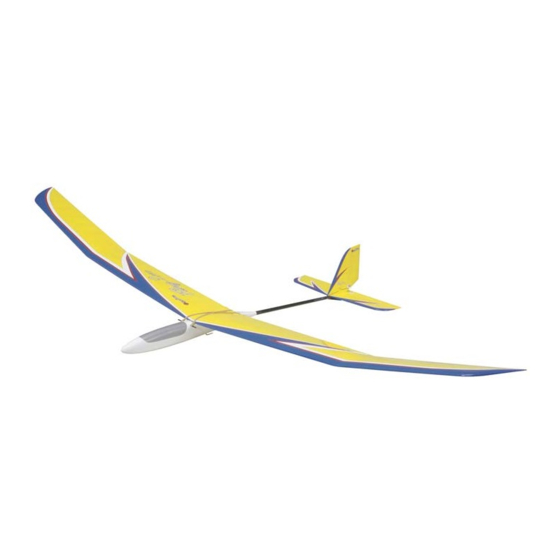GREAT PLANES Fling 2m ARF Інструкція з експлуатації - Сторінка 11
Переглянути онлайн або завантажити pdf Інструкція з експлуатації для Іграшка GREAT PLANES Fling 2m ARF. GREAT PLANES Fling 2m ARF 16 сторінок.

❏
4. Temporarily place the battery and receiver in the nose
of the fuselage on top of a 1/2" [13 mm] thick strip of foam.
Then, mount the wing and canopy.
❏
5. Check that the plane balances at the recommended
C.G. Move the battery and receiver until the plane balances
on that point. With the battery and receiver mounted as far
forward as possible, it still may be necessary to use stick-on
lead weight to balance the Fling 2M ARF. If you find it
necessary to use stick-on lead weight, attach it to the
underside of the left side of the stab for tail weight or to the
sides of the nose of the fuselage for nose weight.
❏
6. Drill a 1/16" [1.6 mm] hole in the bottom of the fuse in
the rear of the wing opening. Route the antenna through the
forward wing former and out the hole in the bottom of the
fuse. Tape the antenna to the bottom of the fuse.
Apply the Decals
1. Use scissors or a sharp hobby knife to cut the decals from
the sheet.
2. Be certain the model is clean and free from oily
fingerprints and dust. Prepare a dishpan or small bucket with
a mixture of liquid dish soap and warm water–about one
teaspoon of soap per gallon of water. Submerse the decal in
the soap and water and peel off the paper backing. Note:
Even though the decals have a "sticky-back" and are not the
water transfer type, submersing them in soap & water allows
accurate positioning and reduces air bubbles underneath.
3. Position decal on the model where desired. Holding the
decal down, use a paper towel to wipe most of the water away.
4. Use a piece of soft balsa or something similar to
squeegee remaining water from under the decal. Apply the
rest of the decals the same way.
GET THE MODEL READY TO FLY
Check the Control Directions
❏
1. Turn on the transmitter and receiver and center the
trims. If necessary, remove the servo arms from the servos
and reposition them so they are centered. Reinstall the
screws that hold on the servo arms.
❏
2. With the transmitter and receiver still on, check all the
control surfaces to see if they are centered. If necessary, adjust
the "V" bends on the pushrods to center the control surfaces.
❏
3. Make certain that the control surfaces respond in the
correct direction as shown in the diagram. If any of the
controls respond in the wrong direction, use the servo
reversing switch in the transmitter to reverse the servos
connected to those controls. Be certain the control surfaces
have remained centered. Adjust if necessary.
Set the Control Throws
Use a Great Planes AccuThrow (or a ruler) to accurately
measure and set the control throw of each control surface as
indicated in the chart that follows. If your radio does not have
dual rates, we recommend setting the throws at the low
rate setting.
Note: The throws are measured at the widest part of the
elevators and rudder.
These are the recommended control surface throws:
High Rate
ELEVATOR:
1/2" [13 mm] up
1/2" [13 mm] down
RUDDER:
1-1/4" [32 mm] right 5/8" [16 mm] right
1-1/4" [32 mm] left 5/8" [16 mm] left
11
4-CHANNEL
TRANSMITTER
4-CHANNEL
TRANSMITTER
Low Rate
1/4" [6.4 mm] up
1/4" [6.4 mm] down
